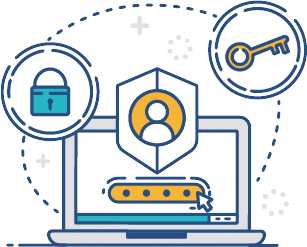What are client portals?
A client portal allows companies to securely exchange information and interact with its customers through a web browser. Usually, it takes the form of a secure area in the cloud, accessible through a company’s website, where a client can log in and can access information, documents, data and can interact with it. For example, a client can upload, view and download documents, fill out webforms, purchase additional services, view product information and marketing materials or chat with a customer representative. A client might also be invited to complete a specific workflow that consists of multiple steps that are required during an onboarding process. Those steps may involve signing documents digitally, going through identity and AML checks and providing consents.
In most cases, to access the portal a client requires a user name and password and, if multiple factor authentication is required, a one-time code or biometric information.
Also, a company may choose to offer access to portals through branded mobile applications with touch-ID turned on and push notifications capabilities.
If you would like to learn more about portals see this Wikipedia article.
Why portals?
Sharing documents via email or tools like Dropbox has a number of problems: from a risk of data leak or identity theft to poor audit trail and generic user experience. In other words, storing sensitive information such as bank account details, copies of identity documents or tax information in an inbox or a general purpose file sharing website looks unprofessional and risky from customer retention perspective. Unsurprisingly, it is increasingly difficult to persuade clients that a company does all it can to protect client’s information. Therefore, only a well designed client portal experience can build the credibility require.
Most people are familiar with a client portal provided by their bank, mobile phone or utility provider. Increasingly a growing number of professional services firms such as wealth managers, accountants, bookkeepers, lawyers, as well as commercial office providers and real estate agents start embracing client portal technology. Moreover, due to its flexibility and configurability, portal technologies can now accommodate increasingly complex requirements including property transactions, M&A deals and private equity investments. In summary, client portals are increasingly used to:
- pitch and sell services
- onboard clients
- exchange documents and data securely
- digitally sign documents
- ensure compliance and security of data
For these reasons client portals are quickly becoming a must-have element of IT infrastructure of a modern professional services firm. Let’s now look at specific benefits.
What are the advantages of client portals?
Client portals benefit both clients and companies. Moreover, one could make an argument that portals are good for the environment by cutting on paper, reducing the need for physical transportation of documents, their storage costs and ultimate disposal costs. They also lower the need for printers and printing supplies. Here is a list of major benefits:
Client benefits:
- 24/7 access to data
- Time saving
- Better experience

Company benefits:
- Higher quality of client relationships
- Better cyber-security
- Lower compliance risk
- Faster client onboarding
- Quicker turn-around time of ongoing transactions
- Reduced infrastructure cost
- Higher staff efficiency
Social benefits
- Lower carbon footprint
What are the essential parts of client portals?
Designing a desired client portal experience requires making some choices. At its simplest, a portal is just a secure file sharing vault. At its most complex, a portal can be a company’s front-of-house experience that is the primary method of onboarding, transacting, and working with your clients. Below we compiled a list of guiding questions or trade-off to make the process easier.
Type of permitted transactions
This is the most important element of the process. Here are some options to consider
- Upload/view/download documents
- Sign forms and documents digitally
- Fill out forms
- Chat
- End-to-end client onboarding workflows
- Purchase services with a credit card or set up a direct debit mandate
- Book appointments
Client signup experience
- Self-service, invitation only or both
- Bespoke or generic portal login URL (for example, portals.your_company.com or your_company.mydocsafe.com or app.mydocsafe.com)
- Own or provider’s email sending address (for example, mydocsafe@mydocsafe.com or portals@my_company.com)
- Your ideal branding experience
- Logo (favicon and imagery for emails and website)
- Brand colours (available palette or bespoke colours)
- Font schema (default schema or own)
Portal structure
- Are clients likely to need access to multiple portals?
- Should portals be shared with multiple stakeholders?
- Do you need a more complex structure such as employee subportals for payroll distribution, or in general, is there a hierarchy of portals that you need to accommodate complex transactions?
- What is the default folder structure for all portals?
- How many types of portals do you need?
- Should chat be enabled?
- Should 2-factor-athentication be enabled by default?
Access considerations
- How will you manage portal access to comply with ‘need to know’ rule?
- Should there be granular access privileges for each individual portal, for example, with some areas accessible to all or some stakeholders, while other areas remaining more restricted?
Portal content
- Do you need to create and share a library of documents or marketing materials?
- What webforms should be accessible for self-service?
- Are there any bespoke workflows that need to be built, for example to onboard a client to a new service, to purchase an additional service or to renew their engagement and KYC information?
Communication channels
Next, have a think about how your clients should be notified about their portal activities. There are two different aspects to communication. Firstly, how one sends out the communication. Secondly, how clients receive and consume it.
- Sending
- Encrypted email messages
- Broadcasting emails
- Publishing announcements manually
- Auto-reminders
- Receiving
- Push notifications on their mobile
- Generic email notifications and reminders
- Bespoke announcements that appear after logging into the portal
Security and compliance considerations
- In what jurisdiction do you need to store the data?
- Do you require internationally recognised security certification?
- Do you need your client data to be managed via a completely separate database?
- Are users logged out automatically after a time of inactivity?
Embedding portals into your digital infrastructure
- How should portals interact with the rest of your IT stack?
- Should information move from portals to third party systems, other way around or should information flow in both directions?
How long does it take?
That depends on requirements. Starting fast has its advantages. However, more blue sky thinking may be necessary if introducing a client portal requires major changes to real business processes.
In most cases it is sufficient to design the simplest use case and launch it first. With MyDocSafe for example, one can start inviting clients to portals instantly. One can add branding and further complexity later.
For more bespoke requirements such as commercial tenant onboarding, wealth management onboarding or even employee onboarding (yes, client portals can be used for internal stakeholders) etc. one could start with a pre-configured template specific to the requirement, if available, and fine-tune it. MyDocSafe has such templates available. In this case the process may take a few weeks.
If your requirements are truly unique, that may be driven by the complexity of the business structure, you should start with a diagram of the required workflows and then configure the portals accordingly. This scenario requires most time and investment but the results can be transformative to some business functions such as compliance or sales.
In general, MyDocSafe caters to all three types of requirements. With this in mind, if you’d wish to see how MyDocSafe can provide you with a client portal to suit your business needs, please start a free trial today or book a demo by filling out the contact form.

